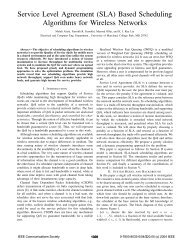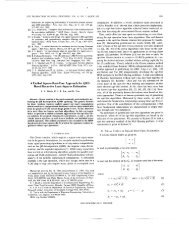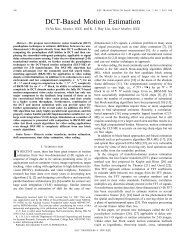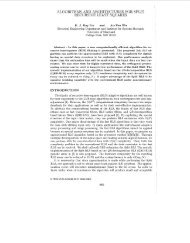Green Wireless Communications: A Time-Reversal Paradigm
Green Wireless Communications: A Time-Reversal Paradigm
Green Wireless Communications: A Time-Reversal Paradigm
Create successful ePaper yourself
Turn your PDF publications into a flip-book with our unique Google optimized e-Paper software.
1708 IEEE JOURNAL ON SELECTED AREAS IN COMMUNICATIONS, VOL. 29, NO. 8, SEPTEMBER 2011<br />
1<br />
0<br />
0.8<br />
−1<br />
−2<br />
0.6<br />
dB<br />
−3<br />
0.4<br />
−4<br />
0.2<br />
−5<br />
0<br />
10<br />
8<br />
6<br />
4<br />
4<br />
2<br />
2<br />
0 0<br />
Multiples of λ /2<br />
Multiples of λ /2<br />
(a) Received signal power (office)<br />
6<br />
8<br />
−6<br />
10<br />
8<br />
6<br />
4<br />
Multiples of λ /2<br />
2<br />
0 0<br />
(a) r I (office)<br />
2<br />
4<br />
Multiples of λ /2<br />
6<br />
8<br />
1<br />
0<br />
−1<br />
0.8<br />
−2<br />
0.6<br />
dB<br />
−3<br />
0.4<br />
−4<br />
0.2<br />
0<br />
8<br />
6<br />
4<br />
Multiples of λ /2<br />
2<br />
0<br />
0<br />
(b) Received signal power (corridor)<br />
2<br />
4<br />
Multiples of λ /2<br />
Fig. 13. Spatial focusing effect of the TR-based transmission from the<br />
experiment measurements.<br />
6<br />
8<br />
−5<br />
−6<br />
8<br />
6<br />
4<br />
Multiples of λ /2<br />
2<br />
0<br />
0<br />
(b) r I (corridor)<br />
2<br />
4<br />
Multiples of λ /2<br />
Fig. 14. Interference alleviation by the TR-based transmission obtained by<br />
the experiment measurements.<br />
6<br />
8<br />
close to the antenna (snapshot 31–40), most of the coefficients<br />
are still higher than 0.8. This suggests that good correlation<br />
is maintained even if the environment is varying, and the<br />
achievable spectral efficiency will be much higher than 50 %.<br />
VI. TIME-REVERSAL DIVISION MULTIPLEXING AND<br />
SECURITY<br />
Due to its special features and focusing effect, the TRbased<br />
communications will spark a series of unique wireless<br />
applications, in addition to the low-power low-interference<br />
green communications. In this section, we briefly introduce<br />
two prospective applications based on the TR communication<br />
technology.<br />
A. <strong>Time</strong>-<strong>Reversal</strong> Division Multiplexing<br />
In a multi-user system, different users have to find a way to<br />
share the wireless media. Traditional approaches include time<br />
division multiplexing (TDM), frequency division multiplexing<br />
(FDM), and code division multiplexing (CDM). The recent<br />
advance in multi-input multi-output (MIMO) has brought in a<br />
new multiplexing scheme named spatial division multiplexing<br />
(SDM), where different users can be distinguished by their<br />
channel response vectors due to the equipment of multiple<br />
antennas. In a rich scattering environment, since different<br />
users have different unique multi-path profiles which depend<br />
on their physical locations and TR transmission treats each<br />
path like a virtual antenna, it is possible to utilize multi-path<br />
profiles as a way to distinguish different users, which may<br />
facilitate the multiplexing. Therefore, a new TR-based multiplexing<br />
scheme, time-reversal division multiplexing (TRDM),<br />
for a multiuser downlink system can be developed [18].<br />
The TRDM exploits the nature of the multi-path environment,<br />
utilizes the location-specific signatures between the<br />
base station and multiple users to separate intended signals,<br />
and thus achieves satisfying performance. Furthermore, the<br />
TRDM approach will make possible numerous applications<br />
that require accurately locating the receiver, e.g., automatic<br />
inventory management in a warehouse, and wireless mailbox<br />
where a server could deliver information to a specific office<br />
in a building.






